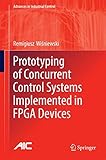Prototyping of Concurrent Control Systems Implemented in FPGA Devices [electronic resource] / by Remigiusz Wiśniewski.
By: Wiśniewski, Remigiusz [author.] .
.
Contributor(s): SpringerLink (Online service) .
.
Material type:  BookSeries: Advances in Industrial Control: Publisher: Cham : Springer International Publishing : Imprint: Springer, 2017Edition: 1st ed. 2017.Description: XI, 173 p. 90 illus., 26 illus. in color. online resource.Content type: text Media type: computer Carrier type: online resourceISBN: 9783319458113.Subject(s): Control engineering
BookSeries: Advances in Industrial Control: Publisher: Cham : Springer International Publishing : Imprint: Springer, 2017Edition: 1st ed. 2017.Description: XI, 173 p. 90 illus., 26 illus. in color. online resource.Content type: text Media type: computer Carrier type: online resourceISBN: 9783319458113.Subject(s): Control engineeringIntroduction -- Related Work -- Perfect Graphs and Comparability Graphs -- Hypergraphs and Exact Transversals -- Analysis of Concurrent Control Systems -- Decomposition of Concurrent Control Systems -- Prototyping of Concurrent Systems -- Modelling of Concurrent Systems in Hardware Languages -- Implementation of Concurrent Control Systems in FPGA.
This book focuses on prototyping aspects of concurrent control systems and their further implementation and partial reconfiguration in programmable devices. Further, it lays out a full prototyping flow for concurrent control systems. Based on a given primary specification, a system is described with an interpreted Petri net, which naturally reflects the concurrent and sequential relationships of the design. The book shows that, apart from the traditional option of static configuration of the entire system, the latest programmable devices (especially FPGAs) offer far more sophistication. Partial reconfiguration allows selected parts of the system to be replaced without having to reprogram the entire structure of the device. Approaches to dynamic and static partial reconfiguration of concurrent control systems are presented and described in detail.< The theoretical work is illustrated by examples drawn from various applications, with a milling machine and a traffic-light controller highlighted as representative interpreted Petri nets. Given the ubiquity of concurrent control systems in a huge variety of technological areas including transportation, medicine, artificial intelligence, manufacturing, security and safety and planetary exploration, the innovative software and hardware design methods described here will be of considerable interest to control engineers and systems and circuits researchers in many areas of industry and academia.


There are no comments for this item.